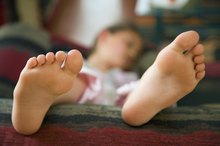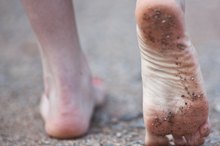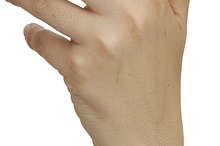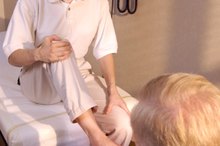Dry, Cracked Feet in Kids
Dry, cracked feet can interfere with most kids' active lifestyles, but the discomfort can be cut short. By considering nutrition, lifestyle, allergies and topical remedies, kids -- and their parents -- may find rapid relief.
Athlete's Foot
Just as mold loves a bathroom, so fungus can develop on perpetually damp feet, leading to symptoms such as cracked, scaly and possibly itchy skin -- otherwise known as athlete's foot 1. Kids who rush out of the shower into their clothes, find more time for exercising than bathing, are slow to change socks after a ball game or walk around barefoot in locker rooms may be more likely to develop chapped, raw, irritated or cracked feet. Discourage sharing footwear or wearing tight, synthetic shoes or socks that prevent feet from "breathing." Encourage your children to wash their feet daily with gentle soap and dry carefully in between the toes, change shoes and socks regularly and go barefoot at home when possible. You may also need to obtain cotton socks, disinfectant spray for the shoes or over-the-counter antifungal products which can be applied directly to the feet. See a pediatrician if the condition of your child's feet fails to improve.
- Just as mold loves a bathroom, so fungus can develop on perpetually damp feet, leading to symptoms such as cracked, scaly and possibly itchy skin -- otherwise known as athlete's foot 1.
- Kids who rush out of the shower into their clothes, find more time for exercising than bathing, are slow to change socks after a ball game or walk around barefoot in locker rooms may be more likely to develop chapped, raw, irritated or cracked feet.
Dry Feet in Winter
Smelly Feet in Children
Learn More
Cold weather presents unique problems for feet. Kids may wear multiple pairs of socks or rubber boots, both of which prevent sweat evaporation. Children who walk to school may spend an entire day with damp feet, which may become irritated, chapped and cracked. Children may unknowingly worsen the condition by scratching itchy feet, which allows bacteria entry beyond the skin's upper layer. Include your child's classroom teacher as part of a team, to ensure that your child is wearing dry, breathable foot gear at school. Repeated long, hot baths can also diminish the natural oils on the skin's surface. Keep bath time short and keep the water temperature down for happier, more moist skin.
- Cold weather presents unique problems for feet.
- Children may unknowingly worsen the condition by scratching itchy feet, which allows bacteria entry beyond the skin's upper layer.
Skin Allergies
Consider any introduction of new cleansing products such as bath soap or laundry detergents. In particular, antibacterial soaps can be unduly harsh on the skin. Ironically, anti-itch and anti-inflammatory products may also irritate skin. If a product increases foot dryness, discomfort or irritation, discontinue it immediately and look for alternatives. Fabric ingredients and dyes in socks and shoes may also cause topical allergies.
- Consider any introduction of new cleansing products such as bath soap or laundry detergents.
- If a product increases foot dryness, discomfort or irritation, discontinue it immediately and look for alternatives.
Skin Hydration and Nutrition
Fissures & Athlete's Feet Treatment
Learn More
The body is 70 percent water, which is circulated continuously. Drinking water throughout the day is a healthy habit to encourage in your children, to promote proper organ health, particularly as the skin is the body's largest organ. Dry, cracked skin may also be a sign of a vitamin A deficiency. Offer vitamin A-rich servings of carrots, peas, apricots, pumpkin or oranges.
- The body is 70 percent water, which is circulated continuously.
- Drinking water throughout the day is a healthy habit to encourage in your children, to promote proper organ health, particularly as the skin is the body's largest organ.
Red Flags
Obesity leads to a myriad of health concerns, including increased pressure on the feet, which can lead to cracked skin. As part of a weight-loss plan, exercise can shift areas of stress and improve overall blood flow to the feet, which can improve skin health and healing. Dry, cracked skin on the feet can also be a symptom of hypothyroidism or complications relating to diabetes 3. Individuals experiencing recent-onset, intense or unusually dry or cracked skin should consult a health care provider 3.
Related Articles
References
- Kids Health: Athlete's Foot
- Merck Manuals: Vitamin A
- HealthyChildren.org: Cracked or Dry Skin
- Institute For Preventive Foot Health. National Foot Health Assessment 2012. 2012.
- Boutrand LB, Thépot A, Muther C, et al. Repeated short climatic change affects the epidermal differentiation program and leads to matrix remodeling in a human organotypic skin model. Clin Cosmet Investig Dermatol. 2017;10:43-50. doi:10.2147/CCID.S120800
- Kapur S, Watson W, Carr S. Atopic dermatitis. Allergy Asthma Clin Immunol. 2018;14(Suppl 2):52. doi:10.1186/s13223-018-0281-6
- Safer JD. Thyroid hormone action on skin. Dermatoendocrinol. 2011;3(3):211-215. doi:10.4161/derm.3.3.17027
- Hashizume H. Skin aging and dry skin. J Dermatol. 2004;31(8):603-609. doi:10.1111/j.1346-8138.2004.tb00565.x
- Parker J, Scharfbillig R, Jones S. Moisturisers for the treatment of foot xerosis: a systematic review. J Foot Ankle Res. 2017;10:9. doi:10.1186/s13047-017-0190-9
- Linus Pauling Institute. (2012-2016). Oregon State University: Micronutrient Information Center: Essential Fatty Acids and Skin Health.
Writer Bio
Sophie Bloom has been a professional writer since 2000, writing for nonprofits including the American Foundation for the Blind and The Adult Literacy Media Alliance. She received her Bachelor of Arts degree in culture and media studies from Johns Hopkins University and her Master of Science in acupuncture from Tri-State College of Acupuncture in New York City.








